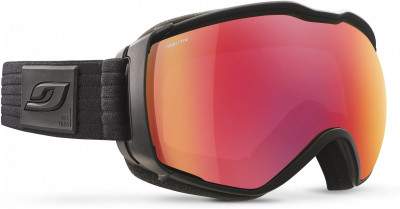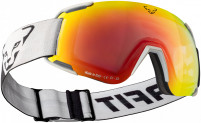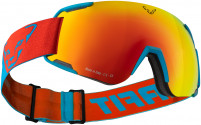Finally, some goggles that work for uphill skiing. Julbo has an ingeniously simple plan for tackling the inevitable fogging that occurs if you ski with a typical goggle in the backcountry. With their unique system, all you need to do is pull the lens away from your face, popping the lens open and leaving a sub-centimeter gap all around the glass. This is just enough to let the steam escape and to allow a freshening flow of air to work across your brow. If the weather is bad, push the lens back in for maximum weather protection on the down, or ski with ‘em open for a nice breeze.
The Aerospace Goggle comes in an assortment of colors and lenses to match your style and climate. The amazing Zebra is the same transition lens found in the sunglasses we’ve been skiing with for years, and with a huge range of light adaptability, you can leave them on from dawn to dusk. Julbo is the leader in photochromic technology, and they've outdone even themselves with the REACTIV technology. The lenses are even clearer and the transition between modes even faster (which all skimo aficionados strive for). The Aerospace is far and away the best ski touring goggle available.
- SuperFlow system lets you push the lens away from your face while ascending.
- Extra-large chassis doesn’t inhibit your view like so many goggles on the market.
- Minimalist frame is comfortably fit and the spherical lenses don’t distort your vision.
- All lenses have an anti-fog treatment that works in combination with the airflow.
- Flash treatment aids in glare protection and helps increase your coolness quotient.
Update 2019/20: With the introduction of their REACTIV lenses, Julbo has improved upon their already impressive lens line. These photochromic lenses react to changing light conditions faster and can accommodate a wider range of lighting conditions than any other Julbo lenses. See the chart (found in 'product images') for a full rundown of the REACTIV line and detailed explanations of each lens.
Update 2023/24: Julbo replaced this google with the Lightyear.
Related Products
Questions & Reviews
My one issue with these is that it is a pain to get the lens secured back into the frame. Though they appear to be good, I can hear a fair amount of wind noise when moving fast. For better or worse, I don't ski very fast downhill when touring so the noise isn't bad, but definitely noticeable. Maybe I need to stop and really make sure the lens is seated but I'd rather not have to take them off and fiddle.
I rarely use the pop-out lens feature. I try to avoid doing any climbing in goggles, but it can be nice to pop them out to avoid fogging if you have to work hard. I usually only wear goggles if its cold/windy/snowing or I'm in a resort, and when you pop out the lenses it lets in some of the elements. I'm also afraid I'd break the lens but it has held up well so far for me. If I need the ventilation I usually just switch to sunglasses which I always carry.
Perfect.
Able to regulate the air flow and enjoy the day.
Only thing she has been able to wear and not struggle with her eyes watering.
The lenses scratch remarkably easily, then again all mirrored lenses do. I ruined one pair, and babied the second. On especially cold days the lenses change tint much slower, an odd problem.
I've owned both the snow tiger and the zebra light red. Snow tiger is not the best in low light conditions, zebra light is ok, but still not as good as the old red tinted lenses. Both perform well on bright sunny days.
more moving parts worry me with multiple transitions, long season etc. any reports on that?
i don't often need or like to hike with goggles on but there are days...
The lenses are very crisp and your vision is acute and clear. The photochromic lens changes quickly and is great for skiing a wide open slope, dropping into a shaded chute, ducking into the trees, and then popping back out into full sun. I never felt like I was struggling to deal with the brightness level. Even low-light when the sun was going down or coming up, I never felt like I wished I gone with the Zebra Light lenses.
My biggest complain is that I absolutely cannot use these in flat light. Granted I have an astigmatism, which I've been told makes flat-light conditions all the more difficult, but without a little help from the sun, I can't see the slightest bit of contour or texture on a slope with the Zebra lens. Now, I certainly am not complaining about this, I don't expect a single pair of goggles to do everything perfectly, this is just what I have found to be their achilles heal.
On to the frames - The large lenses and frames give you great field of vision (oh, the snazzy, Euro, tunnel-vision-goggles of old, how I do not miss you). The pop-forward lens to ventilate works extremely well - though after popping them forward the first time I haven't been able to secure them fully-shut again (though, honestly I haven't needed to).
Whether you're skinning up in blustery conditions, or going the lazy route on a lift, these goggles give you protection and excellent ventilation. Sure, they'll fog from time to time - particularly in a hard effort - but as you get your heart rate back down out of the red zone they clear up very quickly and I haven't had any issues with compromised vision when I needed to be able to see clearly - but, please note, I don't race, so I can't speak to their usefulness in that space. As I do more fitness skinning this winter (who knows maybe a race or two could be in my future in coming seasons), I'll see how the ventilation works when I'm really doing consistent high-output skinning and booting, but I'm guessing they'll be pretty solid.
I was between the Julbo goggles and the Smith Chroma Pop with the light orange lenses. I'm very happy with my decision to stick with the Julbos. I'll keep the regular Zebras for bright days, because they are great for those. But the Zebra Light Red lens is perfect for everything that the regular Zebra isn't.
Have you compared the ZL Red with other high-contrast lenses (Oakley Prizm, Giro Vivids, the Chromapops,...) by any chance? THANKS!
Earn store credit by writing reviews. Learn more.

















